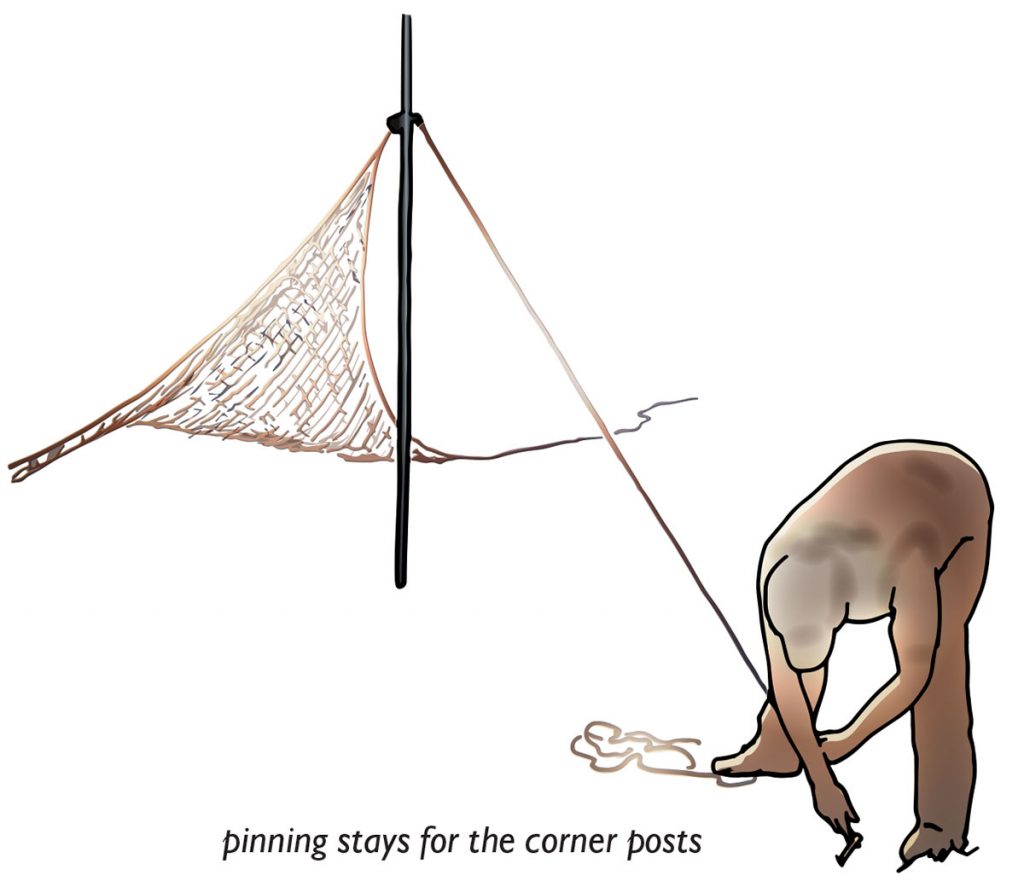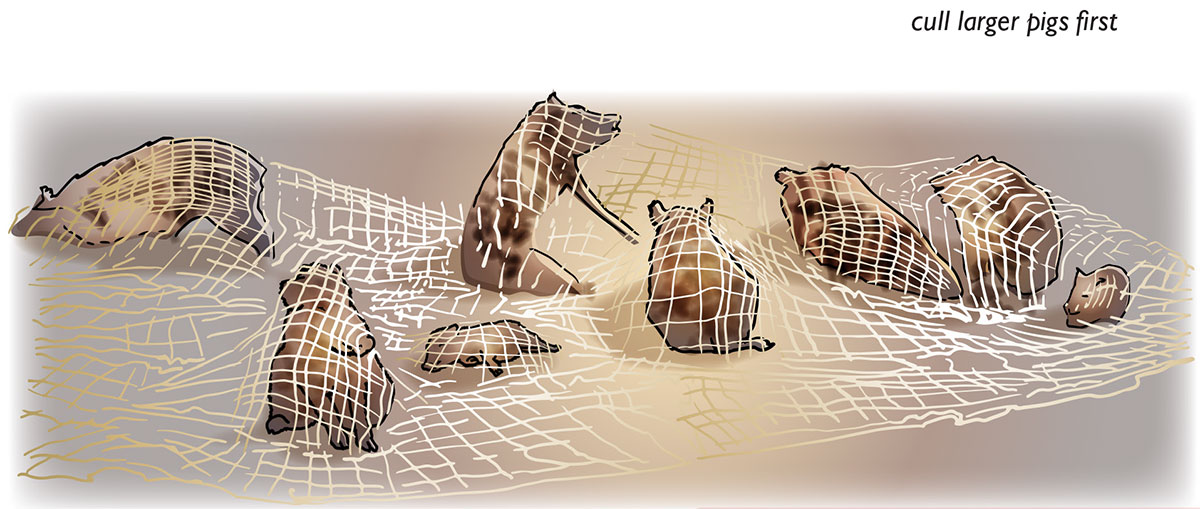
Using drop nets to control feral pigs
Drop net systems can be used as an aid to controlling feral pig populations. The nets allow the capture and dispatch of whole sounders or family groups. This guide explains how to use a drop net trap. See shooting guide* and carcass treatment** guides for information about firearm and ammunition selection, carcass extraction and handling.
Drop net capture systems can be purchased online and they include a variety of release mechanisms.
This guidance is based on experience with a netting system from Wildlife Capture Services https://www.wildlifecapture.com/shop/p/drop-net-kits from Flagstaff, Arizona, where the release mechanism uses electromagnets. The net is a knotted 6-inch (150mm) square mesh made of soft twisted nylon with a twine gauge # 72 (equivalent to 3.17mm diameter), with a breaking strain of 665lbs (302kg). It is available in sizes of of 60 ft X 60 ft (approx 18m X18m) or 40 ft X 40 ft. (approx. 12m x 12m).


Site selection
Select a site
- that is relatively flat, free of tree roots, large boulders, bushes, brush stumps etc. which will help ensure the net drops flat on the ground and avoids gaps through which pigs could escape
- with a cleared area larger than the net size, allowing space for setting of support stays and easing access around the site. .
- on soft ground, with no large stones which will help minimise risk of bullet ricochet.
- without any above ground or under ground services
- with vehicular access for an 4x4, ATC or ATV in order to reduce manual handling of heavy equipment and carcasses
- where a portable lean-to high-seat can be used for observation, net deployment & animal despatch
- where feral pigs feel safe to feed and which is serviced by established animal tracks
- with easy access to enable baiting and checking trail cams.
- away from areas/trails used frequently by the public.
- with few access points (roads, tracks) which operators can readily monitor
Setting up the drop net

The manufacturers supply instructions*** for setting up the drop net. We offer the following tips:
- A heavy hammer and pinch bar will be needed. This is heavy kit, so vehicle access is desirable
- We recommend you add reflective tape to the straps and to the edges of the net, in order to make them visible at night
- Each size of net is supplied with a particular length of electric cable. We recommend you colour code the cables and nets to ease selection.
- When rolling out the net, make it as square as possible to aid sighting of corner posts
- Set the height of the corner release harness at circa 6’ to allow any subsequent work on the harness mechanism to take place easily and safely from ground level.
- Ensure all electric cables are suspended above the ground and cable-tied to corner poles to reduce risks of entangling and prevent damage to equipment
Dropping the Net
Test the system by activating it from the firing position (observation high-seat) in advance of attempting animal capture. Make sure none of the cables interfere with the net deployment.
High-seats
Use a portable high-seat to:
- View the drop net site
- Minimise the chances of targets scenting your presence
- Observe when to trigger the net release switch
- Provide a stable position to despatch pigs from, if required
When positioning your high-seat:
- Take account of prevailing wind
- Take account of the routes that pigs use to pass through the drop net site
- Make best use of the topography
- Try to locate the seat as far away as possible while still enabling the drop to be activated and accurate despatch of pigs, as required.
- Enable safe and discreet access by shooter / assistant in poor light
High-seats may be used in different ways:
- One high-seat, overlooking the site from which the net is triggered and the pigs are dispatched.
- Two high-seats; one as far away as possible, so the net site can be monitored (with Thermal Imaging) and triggered. And another seat, closer from which to dispatch the pigs
- A third option involves one seat for observation and trigger, but despatch of pigs from the ground.
Firearms
- You must use a firearm which is safe to deploy at close range with a minimum Win calibre .270 using an expanding bullet of not less than 150 grains or non-lead equivalent e.g. copper 110 grain in 270, zeroed to match planned dispatch distance
- Use either a thermal imaging scope or normal scope with attached spotlight.
- Rifles with drop-down magazines should be used as magazine can be fitted when safe to do so and additional pre-loaded drop-down magazines carried for use when dealing with multiple pigs at one time.
Trapping
Before trapping:


Before setting the traps, Police Scotland should be informed of the intended operation.
Use a minimum number of two people both of whom are trained for shooting. Additional support should be stationed away from the drop net site but in relatively close proximity to be radioed for assistance with carcass recovery once the pigs have been dispatched.
All personnel involved must visit the drop net site in daylight and observe main access points, location of high-seats and any other site specific risks. They must be familiar with the site specific method statement.
Ensure aware of pig anatomy - see carcass guide. A clear process for dispatch should be described through the site method statement.
Feral pigs can be can be baited under the net with maize. You should set camera traps to show the net site and periphery to gather information about the animals that are visiting (group size, mix of age/sex, dependency of young, size of any piglets and frequency/timing/ predictability of visits).
Concentrate the bait near the centre of the drop net in small piles to increase the chances of catching the whole group.
Decision to drop the net should be made to maximise chances of catching the entire sounder i.e. make sure all sounder individuals are near centre of net and feeding. If after dark, use a hand held TI to observe.
Feral pigs react quickly to the net dropping and there is a risk that any pigs located further than 2-3m from the centre pole will evade capture. Before net is dropped, make a mental note of number and demographic of individuals under the net.
Trapping
 Once the net is dropped, do not approach immediately. Allow time for the pigs to entangle and reduce mobility (no longer than 10 mins).
Once the net is dropped, do not approach immediately. Allow time for the pigs to entangle and reduce mobility (no longer than 10 mins).
Shooter and assistant should agree on number and relative location of each pig under the net and should agree on a sequence of culling, with largest pigs first.
At all times communication between shooter and assistant should be maintained.
Dispatch
If dispatch was from a high-seat then shooter/assistant should look with hand held thermal imagers or spotlight for movement or signs of breathing for 5-10 minutes.
If shooter/assistant confirms nothing observed then unload rifle and come down from High-seat and after reloading the rifle, the shooter can move forward to the drop net. Fully charged head torches and/or portable spotlight system are required from this point onwards. The net and guy ropes are a trip hazard, avoid walking on them where possible.

Once at net, observe pigs for movement/breathing. If both shooter/assistant confirm nothing observed then agree intention to move forward to each carcass in turn to confirm death.
Shooter/assistant should move to nearest carcass (from the rear) and confirm death by prodding it from the rear and if required, dispatch with head shot.
Once all pigs are confirmed dead, make rifle safe. Move on to the carcass retrieval phase. It is only at this stage that any additional assistants should be called forward.
Carcass retrieval
- The net should be systematically rolled back, over the pigs, to avoid having to walk on it
- Use appropriate ATC / ATV to reduce manual handling.
- See carcass handling guidance for information about carcass extraction, lardering and Trichinella testing.
- Eviscerate carcasses off-site, at the larder. If it’s not possible to eviscerate pigs at the larder, use a suitable site away from the trapping area, identified prior to the trapping event.
- Arrange carcasses to facilitate cooling and they should be covered if they are being transported in an open-backed vehicle.
- Delay the dismantling and transport of drop net related equipment until daylight conditions if site location allows.

